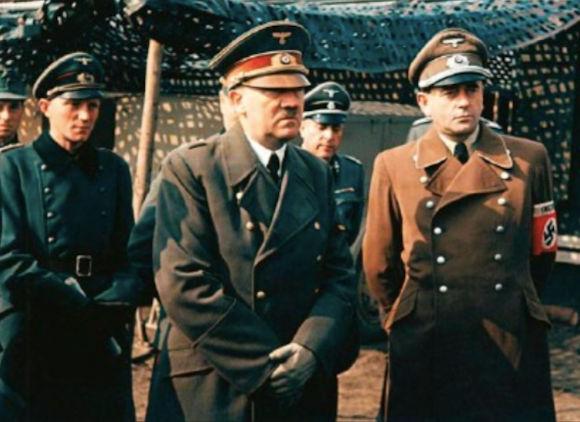Hitler was one step away from getting the most coveted among his science fiction 'Wunderwaffen': a nuclear bomb with which he would rebalance the fate of the Second World War. According to the report OR 696, signed by several agents of the American secret services (OSS) and British (MI6), and accompanied by the direct testimony of four German experts - two physicists, a chemist and a missile expert - Nazi scientists who formally never completed the 'nuclear program' to be used against the enemy, however, would have shown the Führer that a nuclear weapon was achievable. The demonstration took place in October of the 1944 through the test of a 'rudimentary warhead'.
According to the statement of the German pilot Hans Zinsser, who was in flight on the day of the test, an 'atomic fungus' rose to the sky near Ludwigslust. On his flight record, handed over and examined by allied investigators at the end of the war, it reads: "In early October 1944 I was flying 12-15km from the nuclear test station near Ludwigslust, south of Lübeck. A mushroom-shaped cloud with a fluctuating section accompanied by turbulence rises from the ground to a height of about 7000 meters with no apparent connections beyond the point where the explosion took place. Strong disturbances to the electronic equipment make any radio communication impossible and prevent correct consultation of the on-board instrumentation"This report was recently declassified from 'top secret' and comes from the Washington National Archives.
According to estimates, the cloud, which would extend beyond 10 km (6,5 miles), has been described as 'strange and unusual coloration'. The manifestation of the unique mushroom cloud was followed by a shock wave sensed distinctly on the steering bar of the He-111 on which Zinseer stood. According to another flight register consulted by the allied investigators, a second pilot who got up an hour later and took off again in the area near Ludwigslust observed the same phenomenon.
The archive also contained the testimony of the Italian correspondent Luigi Romersa, sent by Mussolini to assist and report on the 'new weapon of the Germans'. Roversa watched the explosion from the ground. It is well known that Hitler pursued with all his resources the goal of mastering nuclear technology in order to be able to use it in an offensive manner or as a deterrence through his ballistic missiles: the Vergeltungswaffe V2 rockets. If the Third Reich had been able to launch even a single missile with atomic power from the Peenemünde base it would undoubtedly have forced the United Kingdom to surrender, thus upsetting the fate of the conflict.
 The testimony of the four German scientists present in the declassified report also mentions a top secret meeting in Berlin in the 1943 between Chancellor Adolf Hitler and the Minister of Armaments Albert Speer: the meeting was reported as a 'nuclear summit'. That the allies were aware of the progress of the Nazi nuclear program based on the studies of 'nuclear fission of uranium' published in the 1939 by scientists Otto Hahn and Fritz Strassmann - concurrent with the Manhattan Project conducted in the United States by Oppenheimer and Fermi - is well known given the numerous military operations that dedicate between the '42 and' 43 to the sabotage of the production of 'heavy water' (deuterium and oxygen): reagent that was used as a chemical moderator for allow the plutonium 239 to radiate nuclear fission. Despite this, the report drawn up by the ally intelligence investigators concludes by stating that it is not believed that the Germans would have been able to trigger a necessary nuclear reaction to cause a controlled nuclear explosion. These conclusions are therefore not able to explain what happened in the skies above Ludwigslust in October 1944. Probably the German scientists evacuated during thePaperclip operation - then hired by the CIA starting in 1946 - they drew more detailed conclusions about it and, perhaps, they realized that they had barely reached ... the atomic bomb!
The testimony of the four German scientists present in the declassified report also mentions a top secret meeting in Berlin in the 1943 between Chancellor Adolf Hitler and the Minister of Armaments Albert Speer: the meeting was reported as a 'nuclear summit'. That the allies were aware of the progress of the Nazi nuclear program based on the studies of 'nuclear fission of uranium' published in the 1939 by scientists Otto Hahn and Fritz Strassmann - concurrent with the Manhattan Project conducted in the United States by Oppenheimer and Fermi - is well known given the numerous military operations that dedicate between the '42 and' 43 to the sabotage of the production of 'heavy water' (deuterium and oxygen): reagent that was used as a chemical moderator for allow the plutonium 239 to radiate nuclear fission. Despite this, the report drawn up by the ally intelligence investigators concludes by stating that it is not believed that the Germans would have been able to trigger a necessary nuclear reaction to cause a controlled nuclear explosion. These conclusions are therefore not able to explain what happened in the skies above Ludwigslust in October 1944. Probably the German scientists evacuated during thePaperclip operation - then hired by the CIA starting in 1946 - they drew more detailed conclusions about it and, perhaps, they realized that they had barely reached ... the atomic bomb!












